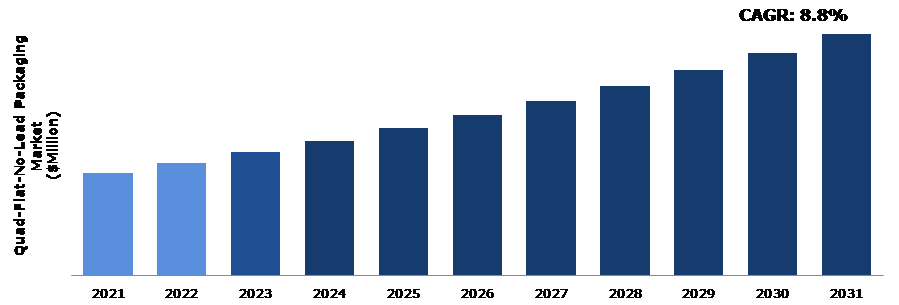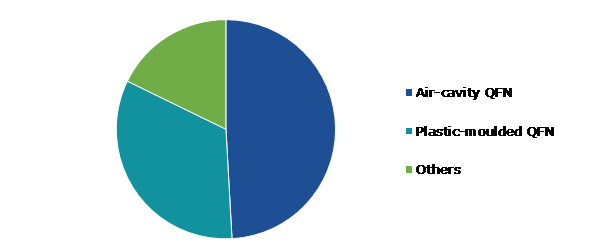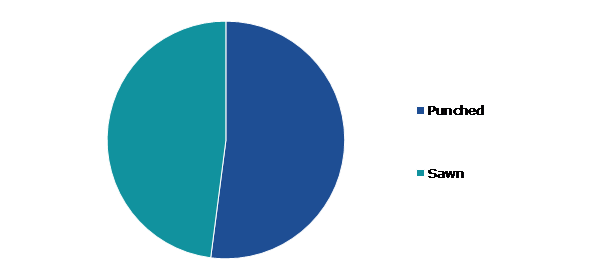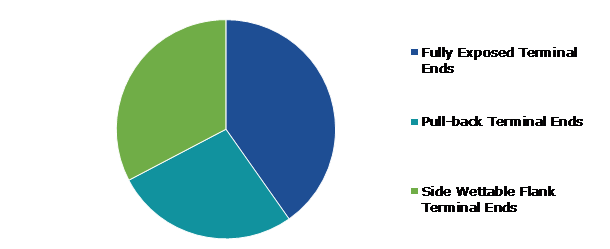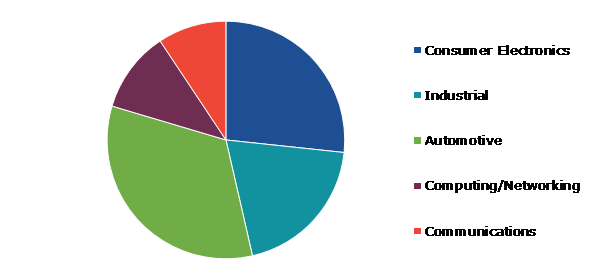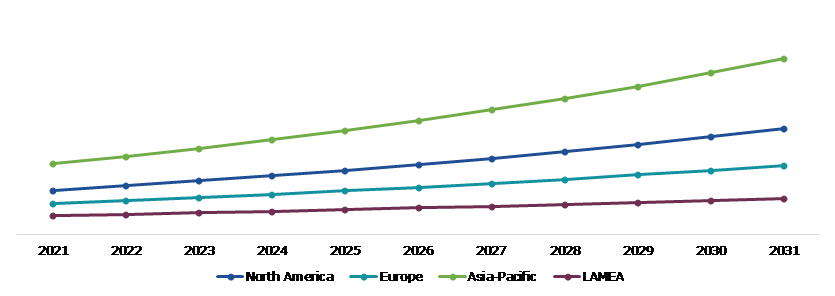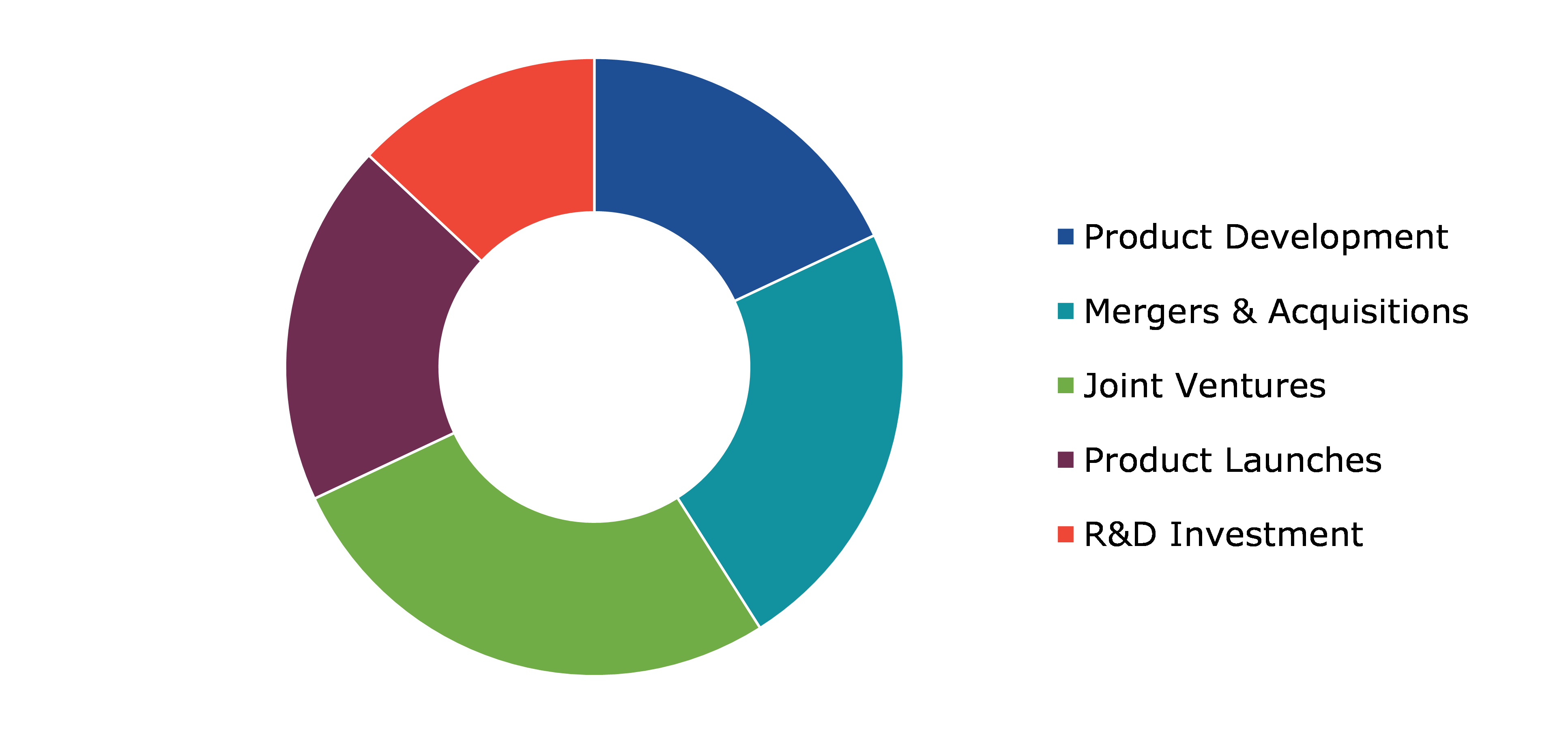Global Quad-Flat-No-Lead Packaging Market Report
RA08601
Global Quad-Flat-No-Lead Packaging Market by Type (Air-cavity QFN, Plastic-Moulded QFN, and Others), Moulding Method (Punched and Sawn), Terminal Pads (Fully Exposed Terminal Ends, Pull-back Terminal Ends, and Side Wettable Flank Terminal Ends), Industry Vertical (Consumer Electronics, Industrial, Automotive, Computing/Networking, Communications), and Regional Analysis (North America, Europe, Asia-Pacific, and LAMEA): Global Opportunity Analysis and Industry Forecast, 2022-2031
Global Quad-Flat-No-Lead Packaging Market Analysis
The Global Quad-Flat-No-Lead Packaging Market Size was $453.1 million in 2021 and is predicted to grow with a CAGR of 8.8%, by generating a revenue of $1,063 million by 2031.
Global Quad-Flat-No-Lead Packaging Market Synopsis
There are various types of surface-mount Integrated Circuit (IC) packages that are put together on a Printed Circuit Board (PCB). The QFN bundles are the most well-liked of these. These tiny units are appropriate for use in power, automotive, industrial, and consumer applications. The market for quad flat no-leads (QFN) packages is anticipated to expand significantly due to the rising popularity of small electronics like wearable and portable devices. The quad-flat-no-lead technology offers a greater number of pins in the package, increasing the number of I/O pins on an electrical device. This enables manufacturers to combine several components onto a single chip, which reduces the size of the finished product. Due to the growing utilization of consumer electronics like smartphones and tablets during the forecast period, the market is anticipated to experience growth during the forecast period.
However, factors like fluctuating raw material costs, the requirement for greater space for QFN packaging, wirebond challenges, fierce rivalry with WLCSP (Wafer Level Chip Scale Package) and BGA (Ball Grid Array), high costs, and difficulties in assembling the QFN package are limiting the expansion of the global market.
The quad-flat-no-lead packaging is experiencing strong adoption, which is driving the revenue growth of the market. The driving factors include growing demand for wireless applications, increasing adoption of portable devices, small form factors, improved thermal performance, rising applications in the automotive industry, high electrical performance, and increased reliability.
According to regional analysis, the Asia-Pacific quad flat no lead packaging market accounted for highest market share in 2021. The quad-flat-no-lead packaging market in Asia-Pacific region is anticipated to grow at the fastest rate due to rising penetration of smartphone users in region.
Quad-Flat-No-Lead Packaging Overview
The Quad-flat-no-leads package is a small, surface-mount plastic container with no leads that is square or rectangular in shape. It resembles a quad flat package in concept, with the exception that no leads emerge from its sides. As a lead frame-based, plastic-encapsulated chip scale package (CSP) with various applications where size, weight, and thermal and electrical performance are crucial, QFN offers customers a great option. For a variety of applications, including wireless phone, power management, analogue baseband, and Bluetooth devices, QFN packages have shown to be effective.
COVID-19 Impact on Global Quad-Flat-No-Lead Packaging Market
The packaging sector has seen significant change as a result of the COVID-19 pandemic, with demand rising for some types of packaging while falling for others. With the Covid pandemic spreading over the world, institutions' focus switched to handling and containing the disease, for which governments in many countries issued lockdowns, curfews, social exclusion, etc. Industries and enterprises were instructed to temporarily cease operations, which severely restricted their ability to grow. The semiconductor packaging material industry took a hit as a result of the downturn in the automotive, electronics, aerospace, IT, and other industrial areas. Various sectors, such as automotive, manufacturing, and others, have been impacted by this crisis, but numerous other industry verticals, such as healthcare manufacturing, medical devices, and others, have benefited from it. To address such problems, prominent market participants are offering advance solution such as lead frame roughening technology to improve the adhesion of mould compound to meet increasing customer demand.
Growing Applications of Quad-Flat-No-Lead Leading in Air Cavity Sector to Drive the Market Growth
The package of quad-flat-no-lead QFN has an air cavity. It also has three components: a copper lead frame, a plastic-molded body, and a lid made of ceramic or plastic (without seal and opened). Additionally, the cost of this sort of QFN is high due to how it is made. However, it can be utilized for microwave applications between 20 and 25 GHz. For several RF and microwave applications, ceramic air cavity QFN packages made with a high temperature co-fired ceramic (HTCC) are also well-liked. An improved version of the standard plastic moulded QFN is the air-cavity QFN packaging. The chip is surrounded by air, and the metal lead are soldered straight to a printed circuit board. This QFN package has a number of advantages, including reduced lead inductance, a thin profile, and a low weight. Also, the exposed copper die-pad technology delivers superior thermal and electrical performance, and perimeter I/O pads make printed circuit board trace routing easier. The QFN is an excellent option because of these characteristics for a wide range of novel applications where size, weight, and thermal and electrical performance are crucial such as in aviation industry, small compact electronics devices and many other.
To know more about global quad-flat-no-lead packaging market drivers, get in touch with our analysts here.
The Flourishing of Market Players Would be Hampered by The Requirement for Large Initial Investments in ICs of Automobiles
As with any other electrical component the QFN are used to manufactured the electrically connected circuits to PCB’s which are used in automotive industry for various purposes such as for anti-braking systems circuit, sensor, and many others. It could be a significant factor in the market's stalling. High current leakage may lead such chips to malfunction or fail completely, which would trigger a system failure. The whole market for automotive chips may be impacted by it. On the other hand, the development of the market is hampered by the complex design of automotive ICs. Compared to mobile phones or other electronic home goods like televisions and remote controls, the design chain of automobile IC is significantly more complicated. This makes it challenging to build extremely reliable automobile ICs. Additionally, the worldwide quad-flat-no-lead packaging market is anticipated to benefit from the falling prices of ICs and the rising demand for electronics in automobiles.
The Ongoing Advancements in Terms of Integration, Energy Efficiency, and Product Qualities are Predicted to Create Opportunity in The QFN Market
Many businesses struggle to find qualified people and groups to pinpoint energy-efficiency improvements. Performing energy audits, analyzing energy performance data, and adequately justifying chances to implement effective actions in terms of the benefits possible relative to the costs associated with the integration of energy efficiency products are all necessary abilities. However, even while better energy management almost always results in significant energy efficiency increases, there will occasionally be a true need to address technological shortcomings. Lack of access to high-efficiency machinery produced to acceptable current standards could be a hurdle.
To know more about global quad-flat-no-lead packaging market opportunities, get in touch with our analysts here.
Global Quad-Flat-No-Lead Packaging Market, by Type
Based on type, the market has been divided into air-cavity QFN, plastic-moulded QFN, and others. Among these, the air-cavity QFN sub-segment accounted for the highest market share in 2021.
Global Quad-Flat-No-Lead Packaging Market Size, by Type, 2021
Source: Research Dive Analysis
The air-cavity QFN segment accounted a dominant market share in 2021. A packaging type frequently used for Si, GaAs, and GaN RF power transistors is the air cavity ceramic package. For high-power RF applications, it is perfect. A typical structure for an air cavity (AC) package includes a lead frame with gold plating, a flange (or heatsink), a ceramic lid, a ceramic window frame, and epoxy for sealing between the lid and the window frame. The sidewalls and lids of the containers are often made of ceramic material (typically Al2O3), which allows them to resist high temperatures without splitting, melting, flowing, or decomposing. It provides excellent mechanical reliability compared to moulding materials; dry air inside the package has a significantly lower dielectric constant, which lowers losses at high frequencies and improves electrical performance in high-frequency semiconductor circuits. The circuit with high dielectric constants generally degrades faster when subjected to high electric fields than those with low dielectric constants; this factor is anticipated to boost the air-cavity QFN market for quad-flat-no-lead market share
Global Quad-Flat-No-Lead Packaging Market, by Moulding Method
Based on moulding method, the market has been divided into punched and sawn. Among these, the punched sub-segment accounted for highest revenue share in 2021.
Global Quad-Flat-No-Lead Packaging Market Forecast, by Moulding Method, 2021
Source: Research Dive Analysis
The punched sub-segment is anticipated to have a dominant market share in 2021. The package for such an QFN is made using a single mould cavity structure. Additionally, the mould cavity is divided by a punch tool, and hence the name. Using this technique, you can only obtain a single box manufactured. The singulation process used on digital imgae processing (DIP) and Small Outline Integrated Circuit (SOIC) packages and the punch method of singulation are both identical. It is typically only utilized when the lead frame is exposed between consecutive units and the over-molded portion of the QFN is discrete. The "block" over mold format is used in the standard high volume manufacturing process for QFN. During the final assembly process, punch singulated packages are individually "punched" from moulded strips offering a more portable and cost-effective alternative than traditional lead frame packages, especially for handheld and mobile applications. All these factors are anticipated to boost the quad-flat-no-lead packaging market share.
Global Quad-Flat-No-Lead Packaging Market, by Terminal Pads
Based on terminal pads, the market has been divided into fully exposed terminal ends, pull-back terminal ends, and side wettable flank terminal ends. Among these, the fully exposed terminal ends sub-segment accounted for highest revenue share in 2021.
Global Quad-Flat-No-Lead Packaging Market Share, by Terminal Pads, 2021
Source: Research Dive Analysis
The fully exposed terminal ends sub-segment accounted a dominant market share in 2021. The conventional packaging used for consumer and industrial items is the fully exposed terminal end. Because the plating process occurs before package singulation, the side walls of the leads in an Active-Semi standard QFN package are not coated. The terminals are completely exposed at the package edge and package side in this type such as, pull-back terminal ends and side wettable flank terminal ends. Terminal problems such as wireless ad hoc networks can solve by using medium access control layer protocol of multiple access with collision avoidance method.. Both the visible terminal problem and the hidden terminal problem are resolved with it. These factors are anticipated to boost quad-flat-no-lead market share growth.
Global Quad-Flat-No-Lead Packaging Market, by Industry Vertical
Based on Industry Vertical, the market has been divided into consumer electronics, industrial, automotive, computing/networking, communications. Among these, the automotive sub-segment accounted for highest revenue share in 2021.
Global Quad-Flat-No-Lead Packaging Market Analysis, by Industry Vertical, 2021
Source: Research Dive Analysis
The Automotive segment accounted a dominant market share in 2021. This significant development is in the field of the automotive segment such as electronic car accessories. Automobile technology such as keyless entry, auto dimmer headlights, car parking assistance, auto mirror adjust, and other items that are commonly used technologies by car manufactures, generate interest in low-cost packages like UQFN or QFN. Additionally, almost all auto manufacturers offer extra features like keyless entry and open frames for vehicle doors. These devices increase interest in the QFN packaging market. As a result, organizations are investing in the development of new products based quad-flat-no-lead packaging technology.
Global Quad-Flat-No-Lead Packaging Market, Regional Insights
The quad flat no lead packaging market was investigated across North America, Europe, Asia-Pacific, and LAMEA.
Global Quad-Flat-No-Lead Packaging Market Size & Forecast, by Region, 2021-2031 (USD Million)
Source: Research Dive Analysis
The Market for Quad-Flat-No-Lead Packaging in Asia-Pacific to be the Most Dominant
The Asia-Pacific region is anticipated to dominate the global quad flat no lead packaging market during the forecast period. The area is home to numerous cutting-edge semiconductor manufacturing businesses. As a result, the Asia-Pacific region has emerged as the world's leading producer of semiconductors the quad-flat-no-lead technology is used while the production of semiconductors which provides leadless structure to semiconductors. The companies in the Asia-Pacific region are investing on R&D for employing this technology for the manufacturing of electronics circuit boards which are based on QFN technology. For instance, China is getting much closer to being self-sufficient in the fabrication of 7nm chips. One of the major factors driving the expansion of the quad-flat-no-lead packaging market in the region is the rising adoption of smart electronic devices throughout the region. However, Asia-Pacific experiences difficulties with company loss. For instance, Canada has said that it will forbid Huawei and ZTE, two of China's top telecom equipment producers, from contributing to the development of its 5G phone networks. The regional market for semiconductor etches equipment will suffer as a result of this company loss.
Competitive Scenario in the Global Quad-Flat-No-Lead Packaging Market
Investment and agreement are common strategies followed by major market players. For instance, San Jose, California, November 18, 2022—The Semiconductor Industry Association (SIA) has announced that Silicon Labs CEO Matt Johnson has been chosen Chair of the SIA Board of Directors and Rich Templeton, Chairman, President, and CEO of Texas Instruments, has been elected Vice Chair. SIA stands for 99%.
Source: Research Dive Analysis
Some of the leading quad-flat-no-lead packaging market players are Amkor Technology, Inc., Texas Instruments Incorporated, Microchip Technology Inc., STATS ChipPAC Pte Ltd, ASE, NXP Semiconductors, JCET Group,Powertech Technology Inc., Tianshui Huatian Technology Co.,Ltd, ChipMOS TECHNOLOGIES INC.
| Aspect | Particulars |
| Historical Market Estimations | 2020-2021 |
| Base Year for Market Estimation | 2021 |
| Forecast Timeline for Market Projection | 2022-2031 |
| Geographical Scope | North America, Europe, Asia-Pacific, LAMEA |
| Segmentation by Type |
|
| Segmentation by Moulding Method |
|
| Segmentation by Terminal Pads
|
|
| Segmentation by Industry Vertical
|
|
| Key Companies Profiled |
|
Q1. What is the size of the global quad-flat-no-lead packaging market?
A. The size of the global quad-flat-no-lead packaging market was over $453.1 million in 2021 and is projected to reach $1,063 million by 2031.
Q2. Which are the major companies in the quad-flat-no-lead packaging market?
A. Amkor Technology, Inc., Texas Instruments Incorporate, and Microchip Technology Inc. are some of the key players in the global quad-flat-no-lead packaging market.
Q3. Which region, among others, possesses greater investment opportunities in the near future?
A. The Asia-Pacific region possesses great investment opportunities for investors to witness the most promising growth in the future.
Q4. What will be the growth rate of the Asia-Pacific quad-flat-no-lead packaging market during the forecast year?
A. Asia-Pacific quad-flat-no-lead packaging market is anticipated to grow at 9.4% CAGR during the forecast period.
Q5. What are the strategies opted by the leading players in this market?
A. Agreement and investment are the two key strategies opted by the operating companies in this market.
Q6. Which companies are investing more on R&D practices?
A. STATS ChipPAC Pte Ltd, ASE, and NXP Semiconductors are the companies investing more on R&D activities for developing new products and technologies.
1.Research Methodology
1.1.Desk Research
1.2.Real time insights and validation
1.3.Forecast model
1.4.Assumptions and forecast parameters
1.5.Market size estimation
1.5.1.Top-down approach
1.5.2.Bottom-up approach
2.Report Scope
2.1.Market definition
2.2.Key objectives of the study
2.3.Report overview
2.4.Market segmentation
2.5.Overview of the impact of COVID-19 on Global quad-flat-no-lead packaging market
3.Executive Summary
4.Market Overview
4.1.Introduction
4.2.Growth impact forces
4.2.1.Drivers
4.2.2.Restraints
4.2.3.Opportunities
4.3.Market value chain analysis
4.3.1.List of raw material suppliers
4.3.2.List of manufacturers
4.3.3.List of distributors
4.4.Innovation & sustainability matrices
4.4.1.Technology matrix
4.4.2.Regulatory matrix
4.5.Porter’s five forces analysis
4.5.1.Bargaining power of suppliers
4.5.2.Bargaining power of consumers
4.5.3.Threat of substitutes
4.5.4.Threat of new entrants
4.5.5.Competitive rivalry intensity
4.6.PESTLE analysis
4.6.1.Political
4.6.2.Economical
4.6.3.Social
4.6.4.Technological
4.6.5.Environmental
4.7.Impact of COVID-19 on quad-flat-no-lead packaging market
4.7.1.Pre-covid market scenario
4.7.2.Post-covid market scenario
5.Quad-flat-no-lead packaging market analysis, by type
5.1.Overview
5.2.Air-cavity QFN
5.2.1.Definition, key trends, growth factors, and opportunities
5.2.2.Market size analysis, by region, 2021-2031
5.2.3.Market share analysis, by country, 2021-2031
5.3.Plastic-moulded QFN
5.3.1.Definition, key trends, growth factors, and opportunities
5.3.2.Market size analysis, by region, 2021-2031
5.3.3.Market share analysis, by country, 2021-2031
5.4.Others
5.4.1.Definition, key trends, growth factors, and opportunities
5.4.2.Market size analysis, by region, 2021-2031
5.4.3.Market share analysis, by country, 2021-2031
5.5.Research Dive Exclusive Insights
5.5.1.Market attractiveness
5.5.2.Competition heatmap
6.Quad-flat-no-lead packaging market analysis, by moulding method
6.1.Punched
6.1.1.Definition, key trends, growth factors, and opportunities
6.1.2.Market size analysis, by region, 2021-2031
6.1.3.Market share analysis, by country, 2021-2031
6.2.Sawn
6.2.1.Definition, key trends, growth factors, and opportunities
6.2.2.Market size analysis, by region, 2021-2031
6.2.3.Market share analysis, by country, 2021-2031
6.3.Research Dive Exclusive Insights
6.3.1.Market attractiveness
6.3.2.Competition heatmap
7.Quad-flat-no-lead packaging market analysis, by terminal pads
7.1.Fully Exposed Terminal Ends
7.1.1.Definition, key trends, growth factors, and opportunities
7.1.2.Market size analysis, by region, 2021-2031
7.1.3.Market share analysis, by country, 2021-2031
7.2.Pull-back Terminal Ends
7.2.1.Definition, key trends, growth factors, and opportunities
7.2.2.Market size analysis, by region, 2021-2031
7.2.3.Market share analysis, by country, 2021-2031
7.3.Side Wettable Flank Terminal Ends
7.3.1.Definition, key trends, growth factors, and opportunities
7.3.2.Market size analysis, by region, 2021-2031
7.3.3.Market share analysis, by country, 2021-2031
7.4.Research Dive Exclusive Insights
7.4.1.Market attractiveness
7.4.2.Competition heatmap
8.Quad-flat-no-lead packaging market analysis, by industry vertical
8.1.Consumer Electronics
8.1.1.Definition, key trends, growth factors, and opportunities
8.1.2.Market size analysis, by region, 2021-2031
8.1.3.Market share analysis, by country, 2021-2031
8.2.Industrial
8.2.1.Definition, key trends, growth factors, and opportunities
8.2.2.Market size analysis, by region, 2021-2031
8.2.3.Market share analysis, by country, 2021-2031
8.3.Automotive
8.3.1.Definition, key trends, growth factors, and opportunities
8.3.2.Market size analysis, by region, 2021-2031
8.3.3.Market share analysis, by country, 2021-2031
8.4.Computing/Networking
8.4.1.Definition, key trends, growth factors, and opportunities
8.4.2.Market size analysis, by region, 2021-2031
8.4.3.Market share analysis, by country, 2021-2031
8.5.Communications
8.5.1.Definition, key trends, growth factors, and opportunities
8.5.2.Market size analysis, by region, 2021-2031
8.5.3.Market share analysis, by country, 2021-2031
8.6.Research Dive Exclusive Insights
8.6.1.Market attractiveness
8.6.2.Competition heatmap
9.Quad-flat-no-lead packaging market, by Region
9.1.North America
9.1.1.U.S.
9.1.1.1.Market size analysis, by Type, 2021-2031
9.1.1.2.Market size analysis, by Moulding Method, 2021-2031
9.1.1.3.Market size analysis, by Terminal Pads, 2021-2031
9.1.1.4.Market size analysis, by Industry Vertical, 2021-2031
9.1.2.Canada
9.1.2.1.Market size analysis, by Type, 2021-2031
9.1.2.2.Market size analysis, by Moulding Method, 2021-2031
9.1.2.3.Market size analysis, by Terminal Pads, 2021-2031
9.1.2.4.Market size analysis, by Industry Vertical, 2021-2031
9.1.3.Mexico
9.1.3.1.Market size analysis, by Type, 2021-2031
9.1.3.2.Market size analysis, by Moulding Method, 2021-2031
9.1.3.3.Market size analysis, by Terminal Pads, 2021-2031
9.1.3.4.Market size analysis, by Industry Vertical, 2021-2031
9.1.4.Research Dive Exclusive Insights
9.1.4.1.Market attractiveness
9.1.4.2.Competition heatmap
9.2.Europe
9.2.1.Germany
9.2.1.1.Market size analysis, by Type, 2021-2031
9.2.1.2.Market size analysis, by Moulding Method, 2021-2031
9.2.1.3.Market size analysis, by Terminal Pads, 2021-2031
9.2.1.4.Market size analysis, by Industry Vertical, 2021-2031
9.2.2.UK
9.2.2.1.Market size analysis, by Type, 2021-2031
9.2.2.2.Market size analysis, by Moulding Method, 2021-2031
9.2.2.3.Market size analysis, by Terminal Pads, 2021-2031
9.2.2.4.Market size analysis, by Industry Vertical, 2021-2031
9.2.3.France
9.2.3.1.Market size analysis, by Type, 2021-2031
9.2.3.2.Market size analysis, by Moulding Method, 2021-2031
9.2.3.3.Market size analysis, by Terminal Pads, 2021-2031
9.2.3.4.Market size analysis, by Industry Vertical, 2021-2031
9.2.4.Spain
9.2.4.1.Market size analysis, by Type, 2021-2031
9.2.4.2.Market size analysis, by Moulding Method, 2021-2031
9.2.4.3.Market size analysis, by Terminal Pads, 2021-2031
9.2.4.4.Market size analysis, by Industry Vertical, 2021-2031
9.2.5.Italy
9.2.5.1.Market size analysis, by Type, 2021-2031
9.2.5.2.Market size analysis, by Moulding Method, 2021-2031
9.2.5.3.Market size analysis, by Terminal Pads, 2021-2031
9.2.5.4.Market size analysis, by Industry Vertical, 2021-2031
9.2.6.Rest of Europe
9.2.6.1.Market size analysis, by Type, 2021-2031
9.2.6.2.Market size analysis, by Moulding Method, 2021-2031
9.2.6.3.Market size analysis, by Terminal Pads, 2021-2031
9.2.6.4.Market size analysis, by Industry Vertical, 2021-2031
9.2.7.Research Dive Exclusive Insights
9.2.7.1.Market attractiveness
9.2.7.2.Competition heatmap
9.3.Asia Pacific
9.3.1.China
9.3.1.1.Market size analysis, by Type, 2021-2031
9.3.1.2.Market size analysis, by Moulding Method, 2021-2031
9.3.1.3.Market size analysis, by Terminal Pads, 2021-2031
9.3.1.4.Market size analysis, by Industry Vertical, 2021-2031
9.3.2.Japan
9.3.2.1.Market size analysis, by Type, 2021-2031
9.3.2.2.Market size analysis, by Moulding Method, 2021-2031
9.3.2.3.Market size analysis, by Terminal Pads, 2021-2031
9.3.2.4.Market size analysis, by Industry Vertical, 2021-2031
9.3.3.India
9.3.3.1.Market size analysis, by Type, 2021-2031
9.3.3.2.Market size analysis, by Moulding Method, 2021-2031
9.3.3.3.Market size analysis, by Terminal Pads, 2021-2031
9.3.3.4.Market size analysis, by Industry Vertical, 2021-2031
9.3.4.Australia
9.3.4.1.Market size analysis, by Type, 2021-2031
9.3.4.2.Market size analysis, by Moulding Method, 2021-2031
9.3.4.3.Market size analysis, by Terminal Pads, 2021-2031
9.3.4.4.Market size analysis, by Industry Vertical, 2021-2031
9.3.5.South Korea
9.3.5.1.Market size analysis, by Type, 2021-2031
9.3.5.2.Market size analysis, by Moulding Method, 2021-2031
9.3.5.3.Market size analysis, by Terminal Pads, 2021-2031
9.3.5.4.Market size analysis, by Industry Vertical, 2021-2031
9.3.6.Rest of Asia Pacific
9.3.6.1.Market size analysis, by Type, 2021-2031
9.3.6.2.Market size analysis, by Moulding Method, 2021-2031
9.3.6.3.Market size analysis, by Terminal Pads, 2021-2031
9.3.6.4.Market size analysis, by Industry Vertical, 2021-2031
9.3.7.Research Dive Exclusive Insights
9.3.7.1.Market attractiveness
9.3.7.2.Competition heatmap
9.4.LAMEA
9.4.1.Brazil
9.4.1.1.Market size analysis, by Type, 2021-2031
9.4.1.2.Market size analysis, by Moulding Method, 2021-2031
9.4.1.3.Market size analysis, by Terminal Pads, 2021-2031
9.4.1.4.Market size analysis, by Industry Vertical, 2021-2031
9.4.2.Saudi Arabia
9.4.2.1.Market size analysis, by Type, 2021-2031
9.4.2.2.Market size analysis, by Moulding Method, 2021-2031
9.4.2.3.Market size analysis, by Terminal Pads, 2021-2031
9.4.2.4.Market size analysis, by Industry Vertical, 2021-2031
9.4.3.UAE
9.4.3.1.Market size analysis, by Type, 2021-2031
9.4.3.2.Market size analysis, by Moulding Method, 2021-2031
9.4.3.3.Market size analysis, by Terminal Pads, 2021-2031
9.4.3.4.Market size analysis, by Industry Vertical, 2021-2031
9.4.4.South Africa
9.4.4.1.Market size analysis, by Type, 2021-2031
9.4.4.2.Market size analysis, by Moulding Method, 2021-2031
9.4.4.3.Market size analysis, by Terminal Pads, 2021-2031
9.4.4.4.Market size analysis, by Industry Vertical, 2021-2031
9.4.5.Rest of LAMEA
9.4.5.1.Market size analysis, by Type, 2021-2031
9.4.5.2.Market size analysis, by Moulding Method, 2021-2031
9.4.5.3.Market size analysis, by Terminal Pads, 2021-2031
9.4.5.4.Market size analysis, by Industry Vertical, 2021-2031
9.4.6.Research Dive Exclusive Insights
9.4.6.1.Market attractiveness
9.4.6.2.Competition heatmap
10.Competitive Landscape
10.1.Top winning strategies, 2021
10.1.1.By strategy
10.1.2.By year
10.2.Strategic overview
10.3.Market share analysis, 2021
11.Company Profiles
11.1.Amkor Technology, Inc.
11.1.1.Overview
11.1.2.Business segments
11.1.3.Product portfolio
11.1.4.Financial performance
11.1.5.Recent developments
11.1.6.SWOT analysis
11.1.7.Research dive analyst view
11.2.Texas Instruments Incorporated
11.2.1.Overview
11.2.2.Business segments
11.2.3.Product portfolio
11.2.4.Financial performance
11.2.5.Recent developments
11.2.6.SWOT analysis
11.2.7.Research dive analyst view
11.3.Microchip Technology Inc.
11.3.1.Overview
11.3.2.Business segments
11.3.3.Product portfolio
11.3.4.Financial performance
11.3.5.Recent developments
11.3.6.SWOT analysis
11.3.7.Research dive analyst view
11.4.STATS ChipPAC Pte Ltd
11.4.1.Overview
11.4.2.Business segments
11.4.3.Product portfolio
11.4.4.Financial performance
11.4.5.Recent developments
11.4.6.SWOT analysis
11.4.7.Research dive analyst view
11.5.ASE
11.5.1.Overview
11.5.2.Business segments
11.5.3.Product portfolio
11.5.4.Financial performance
11.5.5.Recent developments
11.5.6.SWOT analysis
11.5.7.Research dive analyst view
11.6.NXP Semiconductors
11.6.1.Overview
11.6.2.Business segments
11.6.3.Product portfolio
11.6.4.Financial performance
11.6.5.Recent developments
11.6.6.SWOT analysis
11.6.7.Research dive analyst view
11.7.JCET Group
11.7.1.Overview
11.7.2.Business segments
11.7.3.Product portfolio
11.7.4.Financial performance
11.7.5.Recent developments
11.7.6.SWOT analysis
11.7.7.Research dive analyst view
11.8.Powertech Technology Inc.
11.8.1.Overview
11.8.2.Business segments
11.8.3.Product portfolio
11.8.4.Financial performance
11.8.5.Recent developments
11.8.6.SWOT analysis
11.8.7.Research dive analyst view
11.9.Tianshui Huatian Technology Co.,Ltd
11.9.1.Overview
11.9.2.Business segments
11.9.3.Product portfolio
11.9.4.Financial performance
11.9.5.Recent developments
11.9.6.SWOT analysis
11.9.7.Research dive analyst view
11.10.Chip MOS TECHNOLOGIES INC.
11.10.1.Overview
11.10.2.Business segments
11.10.3.Product portfolio
11.10.4.Financial performance
11.10.5.Recent developments
11.10.6.SWOT analysis
11.10.7.Research dive analyst view
As global mobility increases, customers who want to "remain connected" in the digital world need lighter and smaller products. To satisfy this need, producers of consumer electronics are working to make their products smaller. Miniaturization of products is made possible by thinner, smaller, and thermally improved packages. Quad flat-no-lead (QFN) packages exhibit improved thermal performance. Therefore, QFN packages are the most popular IC package types for bigger important components like microcontrollers.
Quad flat-no-lead is a lead frame based, plastic encapsulated CSP (chip scale package) that offers clients a suitable solution for numerous applications requiring size, weight, thermal, and electrical performance. QFN is a leadless package with electrical connections made through lands positioned on the bottom side of the device to the surface of the PCB (printed circuit board). A QFN package has proven to be useful in a wide range of applications, including power management, wireless handsets, Bluetooth devices, and analogue baseband. It provides a more compact, high-performance, and cost-effective alternative than traditional lead frame packages, which is especially useful for mobile and handheld applications. The global quad-flat-no-lead packaging market is expanding at a rapid pace due to the growing need for compact devices such as portable and wearable devices.
Newest Insights in the Quad-Flat-No-Lead Packaging Market
The increasing applications of quad-flat-no-lead in the air cavity sector is boosting the growth of the global quad-flat-no-lead packaging market. As per a report by Research Dive, the global quad-flat-no-lead packaging market is expected to surpass a revenue of $1,063 million in the 2022-2031 timeframe. The Asia-Pacific quad-flat-no-lead packaging market is expected to observe dominant growth in the years to come. This is because the region has a gigantic demand for quad-flat-no-lead packaging owing to the growing adoption of smart electronic devices in the region.
How are Market Players Responding to the Rising Demand for Quad-Flat-No-Lead Packaging?
Market players are greatly investing in pioneering research and inventions to cater for the growing demand for quad-flat-no-lead packaging in consumer electronics such as tablets and smartphones. Some of the foremost players in the quad-flat-no-lead packaging market are Amkor Technology, Inc., Texas Instruments Incorporated, Amkor Technology, Inc., Microchip Technology Inc., ASE, NXP Semiconductors, STATS ChipPAC Pte Ltd, Tianshui Huatian Technology Co.,Ltd, ChipMOS TECHNOLOGIES INC, JCET Group, Powertech Technology Inc., and others. These players are focused on planning and devising tactics such as mergers and acquisitions, collaborations, novel advances, and partnerships to reach a notable position in the global market. For instance:
- In April 2021, NXP, a Dutch semiconductor manufacturer and designer, introduced the first QFN solution in the world to enable Wi-Fi® 6/6E in high-end computing devices and smartphones.
- In May 2022, TeraView, the first and foremost firm in the world dedicated to terahertz light applications, launched the EOTPR 4500, a technology designed specifically to inspect integrated circuit packages. An innovative product to meet the increasing demand for superior IC packaging.
- In August 2022, Toshiba, a global innovator and leader in high-tech solutions, launched a stepping motor driver IC, which helps to save space on circuit boards. A stepping motor driver IC in a small package with built-in constant-current regulation that eliminates the need for extra circuit components.
COVID-19 Impact on the Global Quad-Flat-No-Lead Packaging Market
The unpredicted rise of the coronavirus pandemic in 2020 has negatively impacted the global quad-flat-no-lead packaging market. During the pandemic period, the focus of institutions shifted to handling the virus, for which governments in many nations enforced curfews, lockdowns, social exclusion, etc. Industries were told to temporarily shut down operations, which significantly limited their capacity to expand. As a result of the slowdown in the automotive, aerospace, electronics, IT, and other industrial sectors, the market for semiconductor packaging materials suffered. Various sectors, like manufacturing, automotive, and others, have been impacted by this crisis, but also had positive effects on many different industries, including medical device manufacturing and the healthcare sector. To overcome from the pandemic impact, key market participants are developing advanced solutions like lead frame roughening technology to enhance mould compound adhesion in order to fulfil rising consumer demand in the post-pandemic period.
Personalize this research
- Triangulate with your own data
- Request your format and definition
- Get a deeper dive on a specific application, geography, customer or competitor
- + 1-888-961-4454 Toll - Free
- support@researchdive.com

